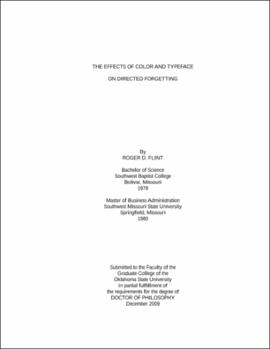| dc.contributor.advisor | Fuqua, Dale | |
| dc.contributor.author | Flint, Roger D. | |
| dc.date.accessioned | 2013-11-26T08:34:27Z | |
| dc.date.available | 2013-11-26T08:34:27Z | |
| dc.date.issued | 2009-12 | |
| dc.identifier.uri | https://hdl.handle.net/11244/7397 | |
| dc.description.abstract | Scope and Method of Study: The purpose of this was to examine the effects of color and typeface on the phenomenon known as directed forgetting using two well-established procedures of eliciting the effect. A total of 184 participants were randomly assigned to the list-method group or item method group, the ARIAL or TIMES NEW ROMAN typeface group, and the red or blue color group. Participants in both item and list method groups viewed 30 words for six seconds each on a computer screen which they were instructed to either remember or forget per the standard procedures applied in each of these procedures. After presentation of the 30 words, a short distractor task (select the capital of these states) was presented on screen. Then, the 89 participants in the ITEM method group were administered a recognition test which included the 30 words originally presented and 15 distractor words which had not previously been seen. All cues were presented in black typeface. The 95 participants in the LIST method were administered a recall task requiring them to type as many of the words they were instructed to remember as they were able to remember. The recall task ended when the time lapsing between entries exceeded 30 seconds. | |
| dc.description.abstract | Findings and Conclusions: Factorial ANOVA results revealed a significant interaction of color and typeface for the number of words correctly recognized (F=.695; df=1; p=.419). Factorial ANOVA results for the LIST method revealed a nonsignificant interaction of color and typeface for words correctly recalled (F=6.104; df=1; p=.015). Simple main effects tests revealed a moderate effect (partial eta squared = .07) for the color blue (F=5.935, df=1, p=.017), but a nonsignificant effect (partial eta squared=.02) for the color red (F=1.514, df = 1, p=.222). The results of the study suggest that perceptual cues play a more significant role in the ability of individuals to forget what they have been instructed to forget than may have been previously examined. | |
| dc.format | application/pdf | |
| dc.language | en_US | |
| dc.rights | Copyright is held by the author who has granted the Oklahoma State University Library the non-exclusive right to share this material in its institutional repository. Contact Digital Library Services at lib-dls@okstate.edu or 405-744-9161 for the permission policy on the use, reproduction or distribution of this material. | |
| dc.title | Effects of color and typeface on directed forgetting | |
| dc.contributor.committeeMember | Davis, Robert | |
| dc.contributor.committeeMember | Miller, Janice | |
| dc.contributor.committeeMember | Perry, Katye | |
| osu.filename | Flint_okstate_0664D_10607.pdf | |
| osu.accesstype | Open Access | |
| dc.type.genre | Dissertation | |
| dc.type.material | Text | |
| dc.subject.keywords | directed forgetting | |
| thesis.degree.discipline | Educational Psychology | |
| thesis.degree.grantor | Oklahoma State University | |
